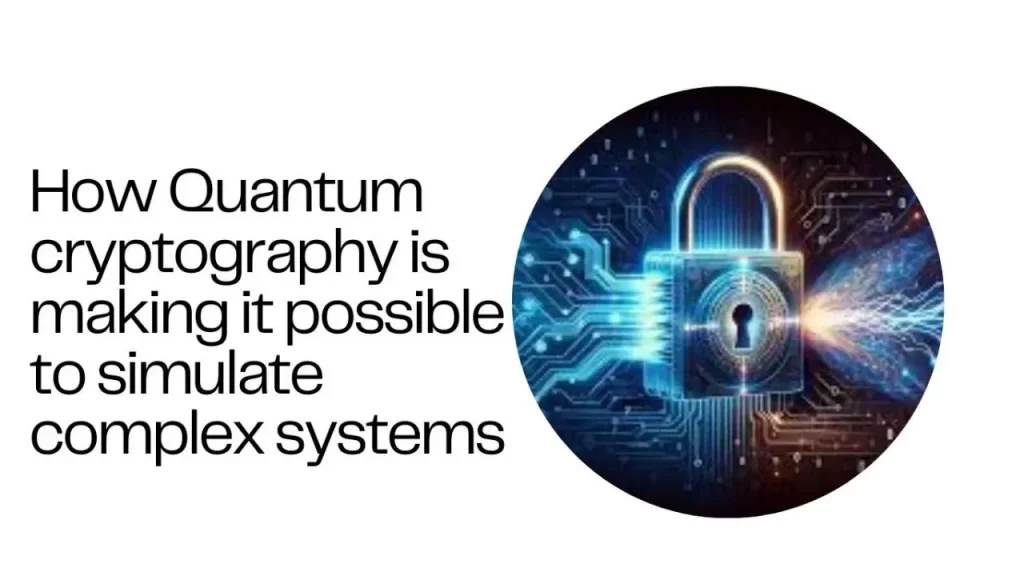
The goal of quantum cryptography is to increase security by using the ideas of quantum physics to develop theoretically unbreakable encryption techniques. The following are the main ways that quantum cryptography improves security:
Quantum Key Distribution (QKD):
Apparently, quantum key distribution (QKD) protocols are the main tools used in quantum cryptography to secure communication channels. QKD generates and distributes cryptographic keys between two parties in such a way that any effort at eavesdropping is apparent by utilizing the concepts of quantum superposition and entanglement.
Unbreakable Key Distribution
The cryptographic key distribution method is made secure using QKD.
The security of classical cryptography depends on the difficulty of mathematical tasks (such as factoring huge numbers), which may be handled by potent quantum computers. QKD, on the other hand, offers information-theoretic security, which makes it theoretically impervious.
Quantum Entanglement and Superposition
Quantum particles can exist in more than one state at once, thanks to quantum superposition.
No matter how physically far apart two particles are, quantum entanglement guarantees that their states are inextricably linked. Secure key distribution is predicated on this attribute.
How to Spot Eavesdropping using Quantum cryptography

Any effort to intercept the quantum key while it is being sent causes detectable disruptions.
According to quantum mechanics, Heisenberg’s Uncertainty Principle states that measuring a particle’s position will inevitably affect its momentum.
Fighting off Quantum Attacks:
The purpose of quantum cryptography is to withstand attacks by quantum computers. Quantum algorithms such as Shor’s algorithm can effectively breach classical cryptography systems that rely on the difficulty of factoring huge numbers. QKD, on the other hand, is still safe from these kinds of assaults.
Security for the Future:
The degree of security offered by quantum cryptography is independent of the computational capacities of classical or quantum computers. Hence, QKD continues to be a promising method for preserving secure communication as quantum computers develop.
Extension of Quantum Keys:
The growth of cryptographic keys during communication is possible with quantum cryptography. By constantly updating keys, this feature improves the security of long-term communications.
Although quantum cryptography is an effective tool for communication security, it is important to remember that there are obstacles to overcome before QKD systems can be implemented in the real world.
These obstacles include the necessity for dependable quantum hardware and the creation of quantum repeaters for long-distance communication. Notwithstanding these obstacles, quantum cryptography’s theoretical underpinnings present a viable path toward obtaining hitherto unheard-of levels of security in communication networks.
Developments in Quantum cryptography Technology

As of January 2022, when I last updated my understanding, quantum technology had advanced rapidly in a number of areas. Here are a few important areas where noteworthy advancements have been made:
Computing in Quantum
Increasing Qubit Counts: In order to create quantum systems with more computing capacity, businesses like IBM, Google, and Rigetti have made progress in raising the qubit count in their quantum processors.
Google asserted that they had reached quantum supremacy in 2019 after proving that their quantum processor could do a certain task more quickly than even the most sophisticated classical supercomputers.
Communication in Quantum:
Long-Distance Quantum Entanglement: The first step toward the creation of quantum communication networks involves entangling quantum particles across larger distances.
Experiments and developments in satellite-based quantum communication are ongoing in order to provide secure international communication.
Sensing in quantum:
Better Quantum Sensors: Improvements in quantum sensors that enable more accurate detection of different physical properties. Applications cover everything from environmental monitoring to healthcare.
The advancement of quantum-enhanced imaging technology aims to increase sensitivity and resolution.
The field of quantum cryptography
Continued attempts are being made to put Quantum Key Distribution (QKD) technologies into practice for secure communication.
Post-quantum cryptography is the study and creation of cryptographic techniques that fend off quantum attacks and guarantee long-term data security.
Quantum Technology and Materials:
Finding of novel quantum materials: Materials science research is revealing novel materials with distinct quantum characteristics.
Applications of Nanotechnology: Using quantum principles in nanotechnology to create cutting-edge materials and gadgets.
Machine Learning in Quantum:
The development and testing of quantum machine learning algorithms is being carried out to investigate any potential benefits they may have over their classical equivalents.
Simulation of Quantum Systems:
Advances in the simulation of complicated quantum systems with quantum computers have a positive impact on materials science, chemistry, and physics research.
The Internet of Quantum Mechanics:
Experiments on Quantum Networks: Ongoing research and demonstrations aimed at creating secure, scalable quantum communication networks that will serve as the basis for the future quantum internet.
Partnerships and Investments:
To advance quantum technology, tech businesses, academic institutions, and governments are collaborating more. notable expenditures on the development of quantum technology.
It’s crucial to remember that the subject of quantum technology is one that is always developing and seeing improvements. Possibly more events have occurred in the landscape since my January 2022 post. Keep checking back for the most recent developments in quantum technology research and news.
Advancements in safe long-distance communication through quantum entanglement

One prominent area of interest in quantum communication research has been advancements in secure long-distance communication via quantum entanglement. Here are a few notable developments:
Distribution of Entanglements Across Extended Distances:
The extent of entanglement dispersal has been expanded by researchers with great success. Photons and other entangled particles have been successfully communicated across vast distances, up to several hundred kilometers.
Utilizing Satellites for Quantum Communication
Quantum entanglement has been shown to be a viable technique for secure communication over long distances using satellite-based tests. One notable instance is the Micius satellite from China, which has been utilized in research involving the dissemination of quantum keys.
Quantum Replicators:
The use of quantum repeaters in fiber-optic networks is essential for increasing the entanglement’s range. To get around the problem of quantum signals deteriorating during long-distance transmission, advances have been made in the development of quantum repeater protocols and technology.
Technologies Using Quantum Memory:
The development of quantum repeaters relies heavily on quantum memory. The development of dependable and effective quantum memory systems for storing and retrieving entangled quantum states has advanced.
Quantum Network Exhibits:
Numerous organizations and research teams have carried out tests demonstrating the viability of building secure quantum networks. Entangled particles are distributed throughout several nodes in these networks.
Experiments with Teleportation:
It has been proven that it is possible to send a particle’s quantum state over long distances without any physical transfer, a phenomenon known as quantum teleportation.
Quantum key distribution (QKD) advancements:
There have been advancements in the speed and efficiency of quantum key distribution (QKD), a crucial application of quantum communication. The goal of research is to improve the usability of QKD systems for practical applications.
Examples of Quantum Cryptography

Developments in secure communication technology have been aided by the demonstration of protocols for quantum cryptography, which take advantage of entanglement to guarantee communication security.
Joint Research Initiatives:
International alliances and partnerships between government agencies, commercial enterprises, and academic institutes have sped up advancements in the subject. The goal of these partnerships is to bring quantum communication technologies to market and standardize them.
Combining Traditional Communication Networks with Integration:
The current classical communication infrastructure is being integrated with quantum communication technology. The creation of hybrid networks that can process information in both quantum and classical domains is one example of this.
Even though these developments are encouraging, there are still issues to be resolved, such as extending the lifetime of entangled particles and increasing the effectiveness of quantum repeaters. The objective of quantum communication research and development is to create scalable and useful quantum communication networks that enable safe communication across international distances.
How Quantum cryptography is making it possible to simulate complex systems

Compared to classical computers, quantum simulations represent and analyze complex systems more effectively by utilizing the ideas of quantum mechanics. Here’s how simulations of complex systems are made possible by quantum technology:
Qubits, or quantum bits:
Qubits, the building blocks of quantum computers, are multistate particles that exhibit superposition. Because of this, quantum computers can represent and process a huge number of possibilities at once, a parallelism that classical bits are unable to do.
Quantum Superposition Parallelism:
Quantum computers use superposition to simulate many possibilities simultaneously, whereas classical computers simulate systems one at a time. This parallelism is especially useful for systems that have a large number of interacting parts.
Entanglement in Quantum
Entangled qubits are correlated in such a way that, independent of their physical separation, the states of one and another determine the other’s state. This characteristic makes it possible to represent and manipulate entangled systems in quantum simulations more effectively.
Quantum System Simulation:
Understanding the behavior of materials, molecules, and particles at the quantum level is made possible by the intrinsic suitability of quantum computers for mimicking other quantum systems. This has applications in physics, quantum chemistry, and material science.
Simulations using Quantum Machine Learning:
Operating on quantum computers, quantum machine learning algorithms can improve simulations by finding patterns and optimizing parameters more effectively than their conventional equivalents. This is useful for simulating and optimizing complex systems.
Effective Quantum State Representation:
Quantum states are difficult for classical computers to accurately represent and model, particularly in systems with lots of interacting particles. Because they are intrinsically quantum systems, quantum computers can naturally represent and control quantum states, resulting in simulations that run more smoothly.
Optimization Issues:
Complex system optimization is one of the areas in which quantum computers shine. This is advantageous in the domains of operations research, finance, and logistics.
Investigating Quantum Events:
Exploration and comprehension of quantum phenomena that are difficult to explore in a laboratory context are made possible by quantum simulations. This covers things like unusual quantum states of matter and quantum phase transitions.
Modeling Systems with Strong Correlations:
Strongly linked quantum systems—where the actions of one particle heavily depend on those of other particles—are difficult for classical simulations to handle. Such systems can be more accurately simulated by quantum computers.
Practical Uses:
Real-world uses for quantum simulations include the development of novel materials, comprehension of intricate chemical processes, optimization of energy generation and storage, and problem-solving in industries like finance and logistics.
Though large-scale, realistic quantum simulations are still in their infancy, there has been progress, and scientists are investigating the ways in which quantum computers can supplement classical methods for simulating complicated systems. Quantum simulations promise to be a useful tool for understanding the behavior of various complex systems as quantum technology develops.
The creation of novel materials with distinct quantum characteristics for a range of uses is known as quantum materials research.
Creating materials with special qualities derived from the ideas of quantum mechanics is the process of developing quantum materials. These materials have characteristics that can be used in a variety of ways. The following are important facets of quantum material development and applications:
1. Superconductors:
Quantum properties: Superconductivity is the ability of certain materials to conduct electricity at low temperatures with zero resistance. Utilizing quantum principles, high-temperature superconductors have potential uses in medical imaging and power transmission.
2. Insulators with topological properties:
Topological insulators are substances that conduct electricity on their surface but act as an insulator in bulk due to the quantum spin hall effect. These materials’ quantum spin Hall effect has uses in quantum computing and spintronics.
3. Atomic Drops:
Quantum Confinement: The dominant phenomenon in quantum dots, which are semiconductor nanoparticles, is quantum confinement. Their distinct electrical characteristics find use in solar cells, medical imaging, and quantum computing.
4. Graphene
Quantum Hall Effect: The quantum Hall effect is demonstrated by graphene, a single layer of carbon atoms. Both the production of robust, lightweight materials and electronics could benefit from its prospective uses.
5. Materials for Quantum Hall:
Quantized Hall Conductance: At low temperatures and high magnetic fields, materials exhibiting the quantum Hall effect have quantized Hall conductance. Precision metrology uses these materials because they offer a standard for resistance measurements.
6. Liquid Spin:
Quantum Spin Liquidity: Quantum spin liquids display unusual magnetic properties in specific materials. Comprehending and utilizing these characteristics could potentially lead to progress in quantum information processing.
7. The Quantum Wire
Quantum Conduction: The qualities of quantum conduction can be seen in extremely thin semiconductor wires. Applications for quantum wires could be found in quantum computing and nanoelectronics.
8. Materials for Quantum Spintronics:
Quantum Spintronics: Information processing materials made for spintronics applications make use of the quantum characteristics of electron spin. These materials may be used in electronics that are quicker and use less energy.
9. Fermions Majorana:
Topological Superconductors: Majorana fermion-hosting materials are interesting for quantum computing because they can be used to create topological qubits, which are more resilient to some kinds of mistakes.
10. Crystals with photonic properties:
Quantum Optics: Photonic crystals allow for the control of photons by modifying the quantum flow of light. Applications of these materials include quantum information processing and quantum communication in quantum optics.
11. Materials for Quantum Sensors:
Quantum Sensing: To get extremely sensitive measurements, materials made for quantum sensors take advantage of quantum characteristics. These sensors are used in a variety of industries, including defense, healthcare, and environmental monitoring.
At the junction of materials science, chemistry, and physics lies a multidisciplinary endeavor: the creation of quantum materials. Researchers are paving the way for advancements in a variety of technology fields, including computer, energy, and sensing applications, as they investigate and comprehend the quantum features of materials.
Limitations and Difficulties with Quantum cryptography

Although quantum technology is very promising, there are a number of issues and restrictions that need to be resolved, which scientists are working to resolve.
The following are some major obstacles:
Decoherence of Qubits:
Challenge: Extremely sensitive to their surroundings are qubits, the quantum equivalents of classical bits. The dependability of quantum calculations can be impacted by interactions with external elements that cause decoherence, or the collapse of the quantum state.
Developments: Error mitigation and quantum error correction codes are being made to solve decoherence problems.
Error rates of quantum gates:
Problem: Error-prone quantum gates are a necessary part of quantum computing. In order to construct quantum computers that are more reliable and scalable, gate error rates must be decreased.
Developments: To reduce error rates, new gate designs, hardware enhancements, and error correction methods are being investigated.
Restricted Qubit Connectivity
Challenge: For quantum calculations, it is essential to establish entanglement between qubits. However, qubit connections are frequently restricted, which affects how effective quantum algorithms are.
Developments: To improve qubit connection, strategies like optimized qubit topologies and superconducting qubit cross-resonance are being worked on.
Scaling Quantum Hardware:
Problem: It’s difficult to scale quantum processors to a lot of qubits while keeping error rates low. We are in the noisy intermediate-scale quantum (NISQ) age of quantum processors today.
Developments: In order to attain scalability, businesses and research facilities are investing in enhancing qubit designs and investigating various physical implementations.
Distance in Quantum Communication:
Challenge: The attenuation of quantum signals in optical fibers limits the range of quantum communication. One persistent difficulty is extending the distance for secure quantum communication.
Advances: To get around distance restrictions, quantum repeaters and satellite-based quantum communication experiments are being developed.
Concept of quantum memory:
Problem: Long-distance quantum communication and quantum repeaters require dependable and efficient quantum memory. One major problem is developing quantum memory with greater coherence periods.
Progress: In order to enhance the functionality of quantum memory, advances in material science and experimental methods are being investigated.
Combining with Traditional Systems:
Challenge: It is a difficult task to integrate quantum computers with traditional computing systems and guarantee smooth information flow between them.
Developments: This is being made to create hybrid quantum-classical systems and interfaces that will make it easier to incorporate quantum computers into current computational processes.
Development of Quantum Software:
Challenge: Software development must undergo a paradigm change in order to create and optimize algorithms for quantum computers. There are difficulties when switching from classical to quantum programming.
Developments: To increase accessibility to quantum computing, software development frameworks and quantum programming languages like Qiskit and Cirq are maturing.
Quantum Standardization and Benchmarking:
Challenge: The variety of quantum hardware makes it difficult to set benchmarks and standards for gauging the performance of quantum processors.
Development: Work is in progress to create uniform measures and standards for evaluating quantum processor performance on a regular basis.
High Need for Resources:
Progress: In order to overcome resource constraints, ongoing research focuses on improving hardware capabilities, creating effective error correction methods, and optimizing algorithms.
Despite these obstacles, continuous research and cooperative initiatives are advancing quantum technology.
Technical obstacles to the expansion of quantum systems

The following are the main technological obstacles to scaling up quantum systems:
Qubit Error Rates and Decoherence:
Challenge: The likelihood of qubit decoherence and increased error rates rises with the number of qubits. Greater complexity in maintaining coherence and decreasing mistakes arises in larger quantum systems.
Consequences: Decoherence has the potential to compromise the accuracy of quantum computing. Error correction becomes essential, but implementing it requires more resources.
Connectivity of Qubits:
Difficulty: For quantum computing, entanglement between qubits must be established and maintained. Maintaining a high enough degree of connectedness gets increasingly difficult as qubit counts rise.
Consequences: Low qubit connections can impair the overall performance of quantum processors and make it more difficult to implement some quantum algorithms effectively.
Quantum Gate Assurance:
Challenge: As the number of qubits increases, achieving high-fidelity quantum gates becomes increasingly challenging. Computational errors can result from the accumulation of quantum gate imperfections.
Implications: For some workloads, low gate fidelity can reduce the benefits of employing quantum computers by affecting the accuracy of quantum operations.
Quantum Coherence, Time, and Memory:
Challenge: In bigger systems, accessing and storing quantum information requires quantum memories with longer coherence durations. Sustaining consistency over long stretches of time becomes difficult.
Consequences: The efficiency of quantum communication protocols and quantum algorithms is restricted by short coherence durations. For scalability, creating dependable quantum memory is essential.
Modular Quantum Hardware on a Large Scale:
Challenge: It is a challenging undertaking to fabricate and control a large number of qubits in a scalable and repeatable manner. Ensuring accuracy and stability in quantum hardware components is getting harder and harder.
Consequences: Qubit performance might vary across the quantum processor due to inconsistent and unstable hardware, which makes it challenging to obtain repeatable and dependable results.
Quantum Linkages:
Problem: Effective links are frequently needed in quantum systems in order to transfer quantum information between qubits. It is a technical difficulty to develop fault-tolerant and scalable quantum interconnects.
Consequences: Insufficient interconnects may hinder the development of large-scale quantum processors with effective communication between qubits.
Requirements for Resources:
Challenge: More processing power is needed for larger quantum systems, both for qubits and gate operations. This puts pressure on the resources used in classical computing for tasks like system calibration and error correction.
Consequences: Handling the computational intricacy involved in scaling quantum systems presents difficulties with hardware, software, and infrastructural needs.
Control of Environment and Temperature:
Problem: In order to improve coherence and minimize thermal noise, quantum systems frequently run at very low temperatures. Thermal control and environmental management provide issues when scaling up under these conditions.
Consequences: Maintaining steady and regulated working conditions is essential to quantum processor performance. In larger systems, controlling heat dissipation becomes increasingly difficult.
Quantum Algorithm Design and Software:
Challenge: It’s a challenging effort to create scalable quantum algorithms and software that can effectively use a lot of qubits. There are difficulties in modifying classical algorithms for quantum systems with several qubits.
Implications: The benefits of large-scale quantum processors may be offset by inefficient algorithms. Novel quantum algorithms designed for scalable quantum structures are being investigated by researchers.
Interaction and Pairing:
Challenge: Unwanted interactions and cross-talk between qubits become more likely as the number of qubits rises.
Consequences: Unchecked cross-talk can cause mistakes and irregularities in quantum processes, compromising the dependability of quantum processors.
In order to fully realize the potential of large-scale quantum computers and achieve realistic scalability in quantum systems, it is imperative to tackle these technological obstacles.
Environmental elements influencing quantum systems’ coherence and stability
Different external conditions can have a major influence on the stability and coherence of quantum systems. Because of their extreme sensitivity to external perturbations, quantum information integrity must be preserved in order to minimize these kinds of disruptions. The stability and coherence of quantum systems can be impacted by the following important external factors:
Warmth:
Impact: Working at temperatures that are normally very low, almost at absolute zero, quantum systems operate frequently. Increased heat has the potential to create thermal noise, which can cause decoherence and decreased stability.
Impact: Decoherence can result from external electromagnetic fields interfering with quantum activities. In particular, magnetic fields have the ability to modify the quantum states and alignment of qubits.
Swelling and Synchronous Noise:
Impact: Disturbances that impact the stability of quantum systems can be introduced by mechanical vibrations and ambient noise. In quantum operations, vibrations can result in mistakes and decoherence.
Radiation:
Impact: In quantum systems, ionizing radiation—which includes cosmic rays and radioactive decay—can cause mistakes and decoherence. It is possible for radiation-induced bit flips to undermine qubit stability.
Impact: Decoherence and mistakes in quantum computing can result from interference with particle quantum states caused by Earth’s magnetic fields and other external sources.
Sound waves and phonons:
Impact: Decoherence in quantum systems can result from interactions with photons and phonons (quantized vibrations) from the surrounding environment. This is particularly important for quantum communication and quantum optics.
Impact: Extraneous noise and interference with quantum states can be caused by impurities in materials used to make quantum components. This is especially pertinent to other quantum components and qubits.
Nuclear and electron spins:
Impact: Decoherence in quantum systems can result from interactions between the spins of adjacent electrons and nuclei in the surrounding environment.
Environmental Conditions:
Impact: The stability of quantum systems can be impacted by variations in ambient parameters like humidity and air pressure.
Interference of Quantum from Different Systems:
Impact: Crosstalk and possible mistakes in quantum calculations can result from nearby quantum devices and experiments interfering with one another.
It is imperative to tackle these external influences in order to preserve the stability and coherence of quantum systems. In order to create controlled environments that are good for quantum activities, complex experimental setups, precise control mechanisms, and isolation methods are used. The goal of ongoing research is to further improve the robustness of quantum systems against external disturbances by developing technologies and approaches.
Potential dangers and ethical issues with Quantum cryptography

As quantum technology develops, it presents hazards and ethical issues in addition to revolutionary possibilities. Here are some important things to think about:
1. Cryptography and Privacy:
Ethical Concern: The security and privacy of sensitive data may be jeopardized by the possibility that quantum computers will defeat popular cryptography systems.
2. Risks to Security:
Ethical Concern: The development of potent quantum computers may lead to security vulnerabilities since they may be able to crack some of the encryption techniques used to protect data storage and communication.
3. Two-in-One Technology:
Ethical Concern: Like many other cutting-edge technologies, quantum technology has the potential to be used for both good and bad.
4. Inequitable Access
Ethical Concern: There is a chance that the advantages of quantum technology will not be distributed equally, which could widen already-existing social and economic divides.
5. Loss of Employment:
Ethical Concern: The broad use of quantum technology may result in the loss of jobs in some industries, as is the case with any technical breakthrough.
6. Effect on the Environment:
Ethical Concern: The creation and application of quantum technologies may have an impact on the environment, notably in relation to the energy requirements of quantum computers and the manufacturing of related hardware.
7. Utilizing Quantum Computing Power Ethically:
Ethical Concern: The enormous processing capability of quantum computers presents moral dilemmas for appropriate and moral applications, particularly in fields like data analysis, artificial intelligence, and surveillance.
8. Use of AI and Machine Learning Ethics:
Ethical Concern: Concerns about privacy, bias, and responsibility may arise from the combination of quantum computing with artificial intelligence (AI) and machine learning.
9. Manipulation of Quantum Information:
Ethical Concern: Data integrity, trust, and the possibility of misinformation are among the ethical issues raised by the ability to manipulate quantum information.
10. Consequences of Quantum Communication for Society and Ethics:
Ethical Concern: The potential misuse, implications for monitoring, and societal effects of the secure communication made possible by quantum technology give rise to ethical concerns.
It is crucial to proactively address these ethical issues and potential hazards as quantum technology develops through interdisciplinary cooperation, moral principles, and responsible research and development procedures. The public, scientists, and ethicists must have an open line of communication in order to successfully navigate the moral challenges posed by quantum technology.
Future Outlook of Quantum Technology
The future outlook of quantum technology is highly promising, with anticipated advancements across various domains. Here are key aspects of the future outlook for quantum technology:
1. Quantum Computing:
Scalability: Continued efforts to overcome technical challenges will likely lead to the development of more scalable and error-tolerant quantum computers with increased qubit counts.
Practical Applications: Progress in quantum algorithms will pave the way for solving complex problems in optimization, cryptography, and simulation, impacting industries such as finance, logistics, and materials science.
2. Quantum Communication:
Quantum Networks: The establishment of quantum communication networks may become more widespread, enabling secure communication over long distances and contributing to the development of a quantum internet.
Satellite-Based Communication: Advances in satellite-based quantum communication could enhance global secure communication capabilities.
3. Quantum Sensing and Imaging:
Quantum Imaging: Quantum-enhanced imaging technologies may see broader adoption, offering improved resolution and sensitivity in various imaging applications.
4. Quantum Materials and Nanotechnology:
Material Discoveries: Ongoing research may lead to the discovery of new quantum materials with unique properties, contributing to advancements in electronics, energy storage, and other applications.
Quantum Nanotechnology: The integration of quantum principles in nanotechnology is likely to result in innovative materials and devices with enhanced capabilities.
5. Quantum Cryptography:
Commercial Adoption: Practical implementations of quantum key distribution may become more prevalent, offering a new paradigm for secure data transfer.
6. Quantum Machine Learning:
Algorithmic Advancements: Progress in quantum machine learning algorithms could lead to improved capabilities in pattern recognition, optimization, and data analysis.
Hybrid Approaches: Integration of quantum computing with classical machine learning techniques may become more common, offering enhanced computational power.
7. Quantum Simulation:
Drug Discovery: Quantum simulations may play a role in accelerating drug discovery processes by modeling molecular interactions more accurately.
8. Quantum Industry Growth:
Commercialization: Quantum technology is likely to see increased commercialization, with more companies entering the space and collaborating on research and development.
Startup Ecosystem: A growing ecosystem of quantum startups may contribute to innovation and the development of practical applications.
9. Quantum Standards and Interoperability:
Standardization Efforts: Efforts to establish standards for quantum technologies and ensure interoperability may gain momentum, facilitating the integration of quantum systems into existing infrastructures.
10. Ethical and Regulatory Frameworks:
Guidelines and Governance: The development of ethical guidelines and regulatory frameworks for the responsible use of quantum technology will be crucial to addressing potential risks and societal concerns. The future of quantum technology is dynamic and evolving, with ongoing research and collaborative efforts shaping its trajectory.
Predictions for the Future of Quantum Technology and its Potential Impact on Society
While predicting the future is inherently uncertain, there are several potential trends and impacts that may characterize the future of quantum technology and its influence on society:
1. Advanced Quantum Computing:
Prediction: Continued advancements in quantum computing could lead to the development of large-scale, fault-tolerant quantum computers capable of solving complex problems beyond the reach of classical computers.
Impact: Accelerated solutions for optimization problems, simulations of quantum systems, drug discovery, and breakthroughs in machine learning could reshape industries and scientific research.
2. Quantum Communication Networks:
Prediction: The establishment of secure quantum communication networks may become more widespread, fostering global communication with unprecedented levels of security.
Impact: Enhanced privacy and secure communication could benefit various sectors, including finance, government, and healthcare.
3. Quantum Sensors and Imaging:
Prediction: Quantum sensors and imaging technologies may see increased adoption, providing unparalleled precision in measurements and imaging applications.
Impact: Advances in healthcare diagnostics, environmental monitoring, and defense capabilities could result in transformative societal benefits.
4. Quantum Cryptography and Security:
Prediction: Practical implementations of quantum key distribution (QKD) could become more prevalent, offering secure communication resistant to quantum attacks.
Impact: improved cybersecurity with unbreakable encryption methods, safeguarding sensitive data in an increasingly digital society.
5. Quantum Machine Learning Integration:
Prediction: Quantum machine learning algorithms may be integrated into various applications, providing quantum-enhanced capabilities for pattern recognition, optimization, and data analysis.
Impact: Improved computational efficiency in machine learning tasks could revolutionize industries such as finance, healthcare, and artificial intelligence.
6. Quantum Simulation for Scientific Discovery:
Prediction: Quantum computers will contribute significantly to simulating complex quantum systems, leading to breakthroughs in materials science, chemistry, and physics.
Impact: Accelerated drug discovery, material design, and scientific understanding of fundamental phenomena could have profound societal implications.
7. Quantum Materials Innovation:
Prediction: The discovery and application of new quantum materials with unique properties may advance electronics, energy storage, and other technological domains.
Impact: Innovative materials could lead to more efficient electronic devices, sustainable energy solutions, and novel technologies.
8. Quantum Industry Growth:
Prediction: Quantum technology will witness increased commercialization with the growth of the quantum industry, fostering a vibrant ecosystem of startups and collaborations.
Impact: Economic growth, job creation, and the emergence of new industries focused on quantum technologies.
9. Ethical Considerations and Governance:
Prediction: The development of ethical guidelines and regulatory frameworks for quantum technology will gain importance, addressing potential risks and societal concerns.
Impact: ensuring responsible and equitable deployment of quantum technologies to mitigate potential negative impacts.
10. Quantum Education and Workforce Development:
Prediction: Increased focus on quantum education and workforce development to address the growing demand for skilled professionals in the quantum industry.
Impact: A well-prepared workforce capable of harnessing quantum technologies, driving innovation, and contributing to economic growth.
While these predictions offer potential scenarios, it’s important to note that the realization of these outcomes will depend on scientific breakthroughs, technological advancements, ethical considerations, and societal readiness.
Investments and research initiatives driving Quantum cryptography development

Here are some notable examples of organizations, companies, and initiatives contributing to the advancement of quantum technology:
1. IBM Quantum Initiative:
The IBM Quantum is a pioneering initiative that provides access to quantum computers via the cloud.
Investments: IBM has made significant investments in quantum computing research, including the development of the IBM Quantum System One, a quantum computer designed for commercial use.
2. Google Quantum AI Lab: Initiative:
Google’s Quantum AI Lab is at the forefront of quantum computing research. Google achieved quantum supremacy in 2019 with its Sycamore processor, demonstrating the potential of quantum computers for specific tasks.
Investments: Google continues to invest in quantum algorithms, hardware, and exploring applications in machine learning and optimization.
3. Microsoft Quantum:
Investments: Microsoft has invested in the development of Quantum Development Kits, which include the Q# programming language and resources for quantum computing.
4. Rigetti Computing:
Investments: Rigetti has secured funding for its quantum computing endeavors, aiming to contribute to the development of scalable and commercially viable quantum systems.
5. IonQ:
Initiative: IonQ specializes in trapped-ion quantum computing. They aim to build scalable and error-tolerant quantum computers.
Investments: IonQ has received significant investments to support its efforts in developing quantum processors and advancing quantum algorithms.
6. Quantum Industry Leaders:
Investments: These companies receive investments for hardware advancements, software development, and exploring applications of quantum technology in various industries.
7. National Quantum Initiatives:
Initiative: Various countries have launched national quantum initiatives to promote quantum research and development. Examples include the U.S. National Quantum Initiative and the European Quantum Flagship.
Investments: Governments allocate substantial funding to support quantum research, infrastructure, and collaborations between academia, industry, and research institutions.
8. Quantum Research Institutions:
Initiative: Leading research institutions, such as MIT, Caltech, and ETH Zurich, are conducting cutting-edge quantum research. They contribute to the theoretical understanding and experimental advancements in quantum technology.
Investments: These institutions receive funding from government grants, industry partnerships, and philanthropic organizations to support quantum research projects.
9. Quantum Software Development:
Initiative: Companies like Zapata Computing and Cambridge Quantum Computing focus on quantum software development, including quantum algorithms and applications.
Investments: These companies secure investments to advance quantum software, making it more accessible and applicable for various industries.
10. International Collaboration:
Initiative: Quantum research often involves international collaboration, with organizations and researchers working together to address global challenges in quantum technology.
Investments: International collaborations receive funding from participating countries, organizations, and multinational research initiatives to foster joint efforts in quantum research and development.
These investments and initiatives underscore the global commitment to advancing quantum technology. The collaborative efforts of industry leaders, research institutions, and governments are driving breakthroughs and shaping the future of quantum computing, communication, and sensing.
Possibilities of Quantum cryptography in Sectors Such as Healthcare, Finance, and Energy
Quantum cryptography holds immense potential to revolutionize various sectors, offering capabilities that classical systems find challenging. Here are the possibilities and potential applications of quantum technology in sectors such as healthcare, finance, and energy:
1. Healthcare:
Drug Discovery: Quantum computers can simulate molecular interactions with high precision, accelerating drug discovery processes and leading to the development of new pharmaceuticals.
Precision Medicine: Quantum sensors can enhance the precision of medical diagnostics, allowing for more accurate imaging and sensing in applications such as magnetic resonance imaging (MRI) and biomarker detection.
2. Finance:
Portfolio Optimization: Quantum computing can optimize complex financial portfolios by quickly assessing a multitude of potential investment scenarios, leading to more effective risk management and improved returns.
3. Energy:
Material Design for Energy Storage: Quantum computing can facilitate the design of new materials with optimal properties for energy storage systems, improving the efficiency and performance of batteries and capacitors.
Optimization of Energy Grids: Quantum algorithms can optimize complex energy distribution networks, helping manage the integration of renewable energy sources and enhancing the efficiency of power grids.
Quantum Sensors for Oil Exploration: Quantum sensors can enhance the precision of measurements in geophysical exploration, leading to more efficient and accurate detection of underground oil and gas reserves.
4. Logistics and Supply Chain:
Optimized Routing and Scheduling: Quantum algorithms can optimize complex logistics and supply chain operations, leading to more efficient routing, scheduling, and inventory management.
5. Telecommunications: Quantum Communication Networks:
Quantum key distribution (QKD) can provide secure communication channels, offering an unprecedented level of encryption and protecting sensitive data in telecommunications.
Quantum Sensors for Network Monitoring: Quantum sensors can enhance the precision of network monitoring by detecting and addressing potential issues in the telecommunications infrastructure.
6. Environmental Monitoring: Climate Modeling:
Therefore, quantum computers can contribute to more accurate climate modeling by simulating complex environmental systems, aiding in the understanding of climate change and its potential impacts. Quantum Sensors for Pollution Detection. Quantum sensors can improve the sensitivity of environmental monitoring devices, facilitating more precise detection of pollutants in air and water.
7. Aerospace and Defense: Quantum Radar and Imaging:
Quantum-enhanced sensors can provide improved radar and imaging capabilities, enhancing situational awareness for aerospace and defense applications.
Optimized Mission Planning: Quantum computers can optimize mission planning and resource allocation, improving the efficiency of defense operations.
While these possibilities highlight the transformative potential of quantum technology, it’s important to note that practical implementation and widespread adoption may require overcoming technical challenges and ensuring the scalability and reliability of quantum systems. Ongoing research and collaborative efforts are essential to unlocking the full potential of quantum technology in diverse sectors.
Conclusion:
In conclusion, the advent of quantum technology marks a groundbreaking era with far-reaching implications across various sectors. The ongoing research and development efforts, coupled with substantial investments from both public and private entities, underscore the commitment to harnessing the unique properties of quantum systems.
Quantum technology, including quantum computing, communication, and sensing, holds immense promise for addressing complex challenges and unlocking unprecedented capabilities.
The possibilities range from revolutionizing drug discovery in healthcare to optimizing financial portfolios, securing communications through quantum cryptography, and enhancing energy efficiency and environmental monitoring.
As the field continues to evolve, the future outlook is optimistic, anticipating the realization of practical quantum applications that can transform industries and reshape the way we approach complex problems.
Quantum technology is poised to contribute to advancements in science, healthcare, finance, energy, and more, opening new frontiers for exploration and discovery.
In navigating this transformative journey, continued international collaboration, investment in research and development, and the establishment of ethical frameworks will be pivotal.
The integration of quantum technology into our societal fabric promises to redefine the possibilities of computation, communication, and exploration, marking a significant leap forward in the realm of science and technology.
A recap of key points discussed
Introduction: Quantum technology represents a paradigm shift in computation, communication, and sensing. Groundbreaking advancements in quantum research are driving the development of practical applications.
Understanding Quantum Technology: Quantum technology harnesses the principles of quantum mechanics, offering unique advantages over classical systems.
Applications of Quantum Technology: Quantum technology has diverse applications across sectors such as healthcare, finance, energy, logistics, and telecommunications.
Computing: Quantum computers have the potential to solve complex problems, with ongoing efforts to improve scalability and error correction.
Communication: Quantum communication enables secure and unbreakable encryption methods, paving the way for quantum-safe communication networks.
Sensing and Imaging: Quantum sensors enhance precision in measurements, while quantum imaging technologies have applications in healthcare and defense.
Quantum Cryptography: Quantum cryptography ensures secure communication by leveraging quantum properties, safeguarding against potential attacks.
Advancements in Quantum Technology:

Ongoing research, industry collaborations, and government initiatives contribute to advancements in quantum technology.
Challenges and Limitations: Qubit decoherence, hardware scalability, and ethical considerations pose challenges that researchers are actively addressing.
Investments and Research Initiatives: Notable organizations and initiatives, both public and private, are driving research and development in quantum technology.
Possibilities in Sectors: Quantum technology holds possibilities in healthcare, finance, energy, logistics, telecommunications, and environmental monitoring.
Recap: Quantum technology‘s promise spans drug discovery, financial optimization, secure communications, energy efficiency, and environmental monitoring.
The collective efforts to advance quantum technology signal a transformative era with far-reaching impacts on science, technology, and society.
Emphasis on the Transformative Nature of Quantum Technology
The transformative nature of quantum technology is paramount, heralding a paradigm shift in how we approach computation, communication, and sensing. Here’s an emphasis on its transformative aspects:
Unprecedented Computational Power:
Quantum computing’s transformative potential lies in its ability to process information exponentially faster than classical computers. This promises breakthroughs in solving complex problems that were previously insurmountable.
Secure Communication Beyond Classical Limits: Quantum communication introduces transformative security measures by leveraging the principles of quantum mechanics. The unbreakable encryption methods it provides have the potential to revolutionize secure communication.
Precision Sensing and Imaging:
Quantum sensors and imaging technologies bring a transformative level of precision to measurements and imaging applications. This has implications for advancements in healthcare diagnostics, environmental monitoring, and defense.
Revolutionizing Drug Discovery and Healthcare:
Quantum technology accelerates drug discovery processes, transforming the landscape of healthcare. Simulating molecular interactions with unparalleled precision opens new avenues for personalized medicine and innovative treatments.
Optimizing Financial Decision-Making:
Quantum computing’s optimization capabilities have transformative implications for finance.
Securing Information with Quantum Cryptography:
The use of quantum cryptography introduces a transformative era in secure communication. It addresses the vulnerabilities of classical encryption methods, ensuring the privacy and integrity of sensitive information.
Potential for Quantum Machine Learning:
The integration of quantum computing with machine learning holds transformative possibilities. Quantum algorithms may revolutionize pattern recognition, optimization tasks, and data analysis, unlocking new frontiers in artificial intelligence.
Environmental Monitoring and Energy Efficiency:
Quantum technology contributes to a transformative approach to environmental challenges. From precise monitoring of pollution to optimizing energy grids, quantum applications offer innovative solutions for a sustainable future.
Global Collaboration and Innovation:
The transformative impact of quantum technology is amplified by global collaboration. Researchers, industries, and governments worldwide contribute to a collective effort that transcends traditional boundaries.
Economic Growth and Job Creation: Quantum technology’s transformative potential extends to economic growth and job creation. The emergence of a quantum industry, startups, and skilled workforce development contribute to a thriving quantum ecosystem.
Shaping the Future of Science and Technology:
Quantum technology is not just a technological advancement; it’s a transformative force shaping the future of science and technology. It opens up possibilities that redefine our understanding of computation, communication, and exploration.
The ongoing journey in quantum research and development holds the key to unlocking its full transformative potential.
Explore the exciting developments Quantum cryptography
Here’s an encouragement for readers to stay informed and embark on the thrilling exploration of this transformative field: 🚀
Embark on a Quantum Odyssey:
Quantum technology is not just a field of study; it’s an odyssey into the unknown Stay curious, and let the mysteries of quantum mechanics unfold before you. 🌌
Witness scientific breakthroughs:
The realm of quantum technology is witnessing scientific breakthroughs that challenge the very fabric of our understanding Stay informed to witness the unveiling of unprecedented possibilities. 🔬
Explore the Quantum Landscape:
Venture into the quantum landscape where computation, communication, and sensing take on a new dimension; thus, explore the potential applications that promise to revolutionize industries. 🧠
Expand Your Quantum Mindset:
Embrace a quantum mindset that goes beyond classical limitations Dive into the principles that govern quantum mechanics and expand your cognitive horizons. 📰
Stay up-to-date with quantum developments:
The pace of developments in quantum technology is rapid Stay informed through reputable sources, scientific journals, and updates from leading organizations to keep abreast of the latest advancements. 🌐
Engage in Quantum Communities:
Join quantum communities, both online and offline, to engage with fellow enthusiasts, researchers, and professionals Participate in discussions and share your passion for the quantum realm. 🔍
Seek learning opportunities.
The quantum landscape is rich with learning opportunities Explore courses, workshops, and educational resources that empower you to understand and contribute to the exciting developments in quantum technology. 🚧
Navigate Challenges with Enthusiasm:
Acknowledge the challenges that come with quantum research and development, but approach them with enthusiasm Each challenge is an opportunity for innovation and advancement. 🌟
Become a Quantum Explorer:
Whether you’re a student, a professional, or simply an inquisitive mind, become a quantum explorer Contribute to the ongoing narrative of quantum technology by staying engaged and proactive. 🚪
Open the Door to Quantum Possibilities:
Quantum technology opens doors to possibilities that were once deemed impossible Embrace the journey, open new doors, and let the quantum revolution unfold.
The quantum future is not just for scientists and researchers—it’s for everyone who is curious, fascinated, and ready to explore the extraordinary. Stay informed, be part of the conversation, and become a pioneer in the quantum era. The quantum odyssey awaits, and the discoveries are boundless!
Frequently Asked Question FAQ
Here’s a set of frequently asked questions (FAQs) about quantum cryptography:
1. What is quantum technology?
Answer: Quantum technology harnesses the principles of quantum mechanics to develop new technologies, including quantum computing, communication, sensing, and cryptography.
2. How does quantum computing differ from classical computing?
Answer: Quantum computing uses qubits, which can exist in multiple states simultaneously (superposition), enabling parallel computations. Classical computers use bits, which are in either a 0 or 1 state.
3. What are the potential applications of quantum technology?
Answer: Quantum technology has applications in healthcare (drug discovery, diagnostics), finance (portfolio optimization, cryptography), energy (material design, grid optimization), and more.
4. What is quantum entanglement?
Answer: Quantum entanglement is a phenomenon where two or more quantum particles become connected in such a way that the state of one particle instantly influences the state of the others, regardless of distance.
5. How does quantum communication provide secure encryption?
Answer: Quantum communication, particularly quantum key distribution (QKD), uses the principles of quantum mechanics to create secure cryptographic keys. Any attempt to intercept the key disrupts the quantum state, alerting the parties involved.
6. What are the challenges in developing quantum computers?
Answer: Challenges include qubit decoherence (loss of quantum information), error correction, and scalability. Therefore, maintaining stable quantum states for a sufficient duration is crucial for effective quantum computation.
7. Can classical computers simulate quantum computers?
Answer: Simulating quantum systems on classical computers becomes impractical for large-scale quantum computations due to the exponential growth in complexity.
8. What role does quantum technology play in environmental monitoring?
Answer: Quantum sensors can enhance precision in environmental monitoring, aiding in pollution detection, climate modeling, and efficient use of resources.
9. Are there quantum technologies already in use?
Answer: Yes, some quantum technologies are in use, including quantum sensors in medical imaging, quantum cryptography for secure communication, and early-stage quantum computers for specific applications.
10. How can one stay informed about quantum technology developments?
Answer: Stay informed through reputable sources, follow updates from leading quantum organizations, participate in quantum communities, and explore educational resources and courses on quantum technology.
11. What are the ethical considerations of quantum cryptography?
Answer: Ethical considerations include privacy concerns due to the potential of breaking classical encryption, ensuring equitable access to quantum benefits, and addressing the societal impact of job displacement.
12. How might quantum technology revolutionize healthcare?
Answer: Quantum technology can accelerate drug discovery, improve diagnostics through enhanced imaging, and contribute to personalized medicine by efficiently analyzing large genomic datasets.
13. Is quantum technology only relevant for large organizations and researchers?
Answer: No, the quantum landscape is inclusive. Enthusiasts, students, and professionals from various backgrounds can explore, learn, and contribute to the exciting developments in quantum technology.







